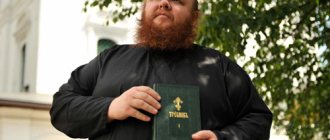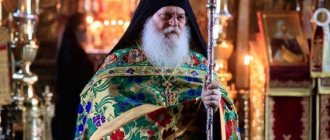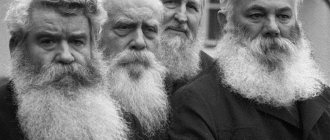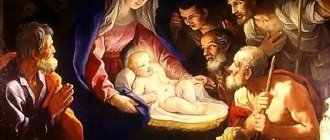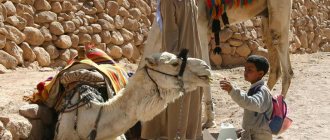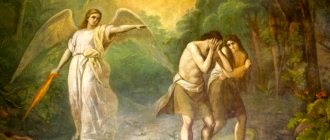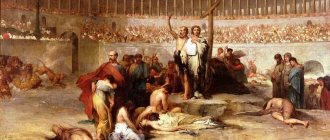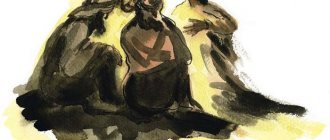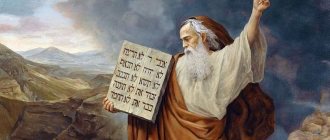From the compiler of the Service Book and Breviary
The Service Book and Breviary of the Iconoclastic Churches was developed using examples of the traditional Offices of the Eastern Rite churches. All Orders of these church documents are offered as a sample, not being an unshakable canon. We understand that the conditions for conducting divine services and national characteristics will require adjustments to the proposed texts of the Offices of the Missal and Breviary, for example, a community conducting services at home (which does not violate the biblical tradition) will be forced to adjust the highly solemn and loud episcopal exclamations when praising the greatness of God, for loud solemn exclamations are designed for the corresponding premises of large temples (houses of prayer). And Christian churches in Western countries will adjust these standards taking into account their church and national traditions. In any church, it is possible to replace the sequence of some points of a particular Rite, provided that the meaning of all liturgical actions is preserved. It is important to maintain the presence of all points in each Chin used, bringing your own adjustment as close as possible to the original.
In the Trebnik and the Missal of Christian Iconoclasts, the two terms “sanctification” and “blessing” are strictly distinguished. The term "sanctification" is applied in the Iconoclastic Churches exclusively to man and to the Word of God (to God), while the term "blessing" can be applied to both man and every thing. In other words, in the Iconoclastic Churches they do not sanctify things, objects, but bless them for their good use. For example, in these two documents the expression “to bless the temple of God” is allowed, but not “to consecrate the temple of God.” For Christ came into this world not to sanctify things, but to change the heart of man and, therefore, to sanctify man, to make him holy. Although in the practice of the Iconoclastic Church the expression “sacred objects” is permissible in relation to church utensils, such a phrase can only express the belonging of these objects to the religious sphere, to the collection of saints - to the Church. At first glance, it may seem that an exception has been made for the consecration of oil in this Breviary. But the name needs to be abbreviated and should be understood as “sanctification followed by anointing with oil.” A person is sanctified first of all through prayer, repentance of sins, and not oil carries within itself a certain holiness that can be transmitted to anyone:
“If any of you is sick, let him call the elders of the Church, and let them pray over him, anointing him with oil in the name of the Lord. And the prayer of faith will heal the sick person, and the Lord will raise him up; and if he has committed sins, they will forgive him. Confess your faults to one another and pray for one another, that you may be healed: the fervent prayer of a righteous man availeth much.”
If we are more consistent with the text of the Bible indicated above, then the Rite of Blessing of Oil is more logical to be called the Rite of Anointing, since we are talking about anointing the sick with oil, and not about blessing with oil.
The breviary does not contain prayers, the meaning of which is associated with the worship of the Virgin Mary, guardian angels, the life-giving cross and saints who have passed into another world. Chinov's texts have been translated from Old Church Slavonic into modern Russian. However, in many Chins, the church style of prayer texts, understandable to Slavs, is preserved, within certain limits (similar to the Synodal translation of the Bible, which differs from modern biblical translations), so that the Chins are not consonant with the secular style of presentation. The iconoclasts waited a long time for the appearance of the Service Book and the Breviary, as well as many Orthodox Christians, who do not adhere to church decrees that distort the truth, but who strive to follow Divine truth, have long wanted to use the Offices in an understandable language. We hope that the Trebnik will be in demand by iconoclasts from around the world, because it reflects the spiritual needs of Christianity and corresponds to the ancient religious traditions of world Christianity.
Prayers on the first day before a wife gives birth
Let's pray to the Lord.
Master Lord Almighty, heal every ailment and every ulcer, Heal Himself even this day who gave birth to Your servant, the name of the Lord, and raise her from her bed, where she lies: forbidden, according to the words of the prophet David , we are wasted in lawlessness, and we are all filthy before By you. Save this and this baby, who gave birth to him: cover her under the roof of Your wing, from this day, even until her last death, with the prayers of the Most Pure Mother of God and all the saints, as a blessing You are forever and ever, amen.
Let's pray to the Lord.
Master Lord our God, born of our Most Pure Lady Theotokos and Ever-Virgin Mary, and like a babe in a manger reclining, and like a child we receive the former: Himself and this thy servant , today she who gave birth to this child, have mercy, and forgive her voluntary and involuntary sins, and preserve her from all torment of the devil: and keep the child born from her from all poison, from all cruelty, from every storm of the enemy, from evil spirits, day and night. Keep this under Thy sovereign hand, and grant it a speedy rise, and cleanse it from filth, and heal illnesses, and grant health and well-being to souls and bodies, and grant this bright and shining angels protect: and protect from all influx of invisible spirits, Lord, from illness and weakness, from jealousy and envy, from the fear of neglect, and have mercy on you and the baby, according to the greatness of Your mercy, and cleanse you from bodily filth, and those who are affected by it in the morning terrible colds, and bring her out with Thy quick mercy in her humble state body for correction: and from this born child grant to worship the earthly temple, which Thou hast prepared to glorify Thy Holy Name.
For due to You is all glory, honor and worship, to the Father, and the Son, and the Holy Spirit, now and ever, and to the ages of ages, amen.
Let's pray to the Lord.
Our Lord God, who was pleased to come down from Heaven and be born of the Holy Mother of God and Ever-Virgin Mary, salvation for us sinners, knowing the weakness of human nature, forgive Thy servant , the name of the one who gave birth today, according to the multitude of Your bounties. For thou art the Lord: grow and multiply, and fill the earth, and subdue it. For this reason, we, Thy servants, pray, and boldly, with Thy kindness and love for mankind, we cry out with fear to the Kingdom of Thy holy name: look down from Heaven and see the weakness of us, the condemned, and forgive This servant of yours, my name, and the whole house, was born in it from birth, and to those who touched her, and to all who are found here, for God is good and a lover of mankind and forgives: for He alone has the power to forgive sins, through the prayers of the Most Pure Mother of God and all Your saints, amen.
Prayer to designate a boy who accepts a name on his 8th birthday
Be aware that after Christmas, on the 8th day, a baby is brought from a woman to the temple, and stands in front of the temple gates.
The priest says: Blessed is our God: Trisagion. Holy Trinity: And according to Our Father: For Thine is the Kingdom:
The same troparion of dismissal for the day or holy temple.
The priest marks his forehead, mouth and chest, and says the prayer:
Let's pray to the Lord.
Lord our God, we pray to You and we ask You, may the light of Your countenance be signified upon this servant of Thy name, and may the Cross of Your Only Begotten Son be signified in the heart and in the mind him, in the hedgehog of the vanity of the world , and from every evil slander of the enemy, and follow Your commandment. And grant, Lord, that I will not deny Your holy name to abide upon him; let us unite at the time of good need for Your holy Church, and perform the terrible mysteries of Your Christ: that we may live according to Your commandments. Having acted as a leader, and having preserved the indestructible seal, he will receive the bliss of the elect in Your Kingdom, grace and love for mankind Thy only begotten Son, with Him art Thou blessed, with Thy Most Holy and Good and Life-giving Spirit, now and ever, and unto the ages of ages, amen.
The same boy, in his hand, stands before the gates of the temple, or before the image of the Most Holy Theotokos, and creates an image of the cross, saying:
Rejoice, Blessed Virgin Mary, / from You has risen the Sun of Truth - Christ our God, / enlightening those in darkness. / Rejoice also, O elder righteous one, / received into the arms of the Liberator of our souls, / who gives us resurrection.
History of the origin of the Trebnik
In addition, the Great Trebnik contains two additional chapters, constituting, as it were, its third part. The first contains a monthly book, the second contains a class (index) of names (saints) in alphabetical order.
The Small Trebnik is an abbreviated version of the Great Trebnik. It contains sequences of sacred rites and prayers that the parish priest most often has to perform. The contents of the first part of the Great Trebnik, with few exceptions, were included in the Small Trebnik. From the second part of the Great Trebnik, the Small Trebnik contains the sequences of the small consecration of water and the consecration of water of the Holy Epiphanies; prayers for the blessing of various foods, for the consecration of buildings and treasures; prayers during the consecration of the desecrated; prayers read during blessing over salt, sowing and the like. The “statement of the most necessary rules” is taken from the Nomocanon, which is shorter in volume than in the Great Trebnik. The Small Trebnik contains the Monthly Book, the sighted Paschal, as well as what is not in the Great Trebnik of later editions, for example: the prayer of Holy Baptisms in brief - “how to baptize a baby briefly for fear of death”; “Canon of prayer to our Lord Jesus Christ and the Most Pure Mother of the Lord during the separation of the soul from the body of every true believer”; prayers “for the Nativity of Christ as a son and spiritual”; prayers at the beginning of the Lenten fast.
The Additional Breviary contains the rites for the consecration of the temple and things belonging mainly to the temple: the cross on the temple, liturgical vessels, sacred vestments, icons, iconostasis, bells, the cross worn on the chest, etc. There is also the rite for the consecration of the artos and prayers for the consecration of objects and things used by Christians outside the church, in home life. These are the prayers for the consecration of a treasure (well), bees, fragrant potions and all things.
The Breviary in 2 parts (Small) contains everything that is in the Small and Additional Breviaries, as well as some prayers from the Large Breviary, for example: “Prayer for all infirmities”, “Prayer to build a ship”, as well as “Ordinance” “When the soul is separated from the body, a person always suffers for a long time.”
The breviary of Metropolitan Peter Mohyla of Kiev was compiled and published by him in 1646 with the aim of providing the southwestern clergy not only with a newly revised official liturgical book, cleared of errors and errors that had crept into the church rituals of Little Russian churches under the influence of Catholicism, but also with a complete and comprehensive practical guidelines for all cases of private worship[3]. Peter Mogila compiled his Trebnik based on Greek euchologies and ancient Slavic written sources. However, in his Breviary he included some rites and prayers with explanatory notes from the Roman Breviary of 1615, edited for the first time under Pope Paul V in 1603. Such a direct borrowing from Roman ritual is, for example, the “Charter of the Mystery of Holy Repentance” in the Breviary of Peter Mohyla[4].
The Trebnik of Peter Mogila also contains articles that, according to their content, are divided into ritual, casuistic and pastoral. Articles of the first type reveal the main idea of the ritual and the meaning of all its accessories; articles of the second type contain instructions for the priest in various difficult cases; the third group indicates the requirements for the shepherd as the performer of the Sacraments and rituals and talks about how the shepherd should relate to his flock.
According to its content, the Trebnik of Peter Mohyla is divided into three parts. The first part contains the rites of the Sacraments and the most important prayers relating to the life of a Christian from his birth to death. In the second part of the Trebnik there are rites for the consecration and blessing of various church accessories and household items of Christians (for example, the consecration of liturgical vessels and clothes, icons). These rites are found in the Breviaries of the Eastern Church and were compiled by Peter Mogila on the basis of the ancient practice of the Eastern Church. The third part contains prayers for events that have the nature of public disasters, for example during a cattle pestilence, as well as events concerning the lives of individual Christians or public groups: a prayer service for the possessed, on New Year’s Day, thanksgiving for receiving help.
Peter Mogila, who died shortly after the publication of his Trebnik, did not have time to submit it for consideration by the All-Russian Patriarch and the Council. The Breviary did not receive widespread distribution and recognition, although some articles from it were included in liturgical books printed in Moscow. These are the “Teaching News” in the Service Book, the rite of joining non-believers, the “Book of Prayer Songs,” etc. This Breviary is used when performing rites, the rites of which are not in the Great Trebnik: for the opening of monasteries, for the acquisition of holy relics. Thus, according to the order set forth in the Trebnik of Peter the Mogila, the discovery of the incorruptible relics of St. Mitrophan of Voronezh in 1832 and St. Tikhon of Zadonsk in 1861 was accomplished.
Breviary in three parts (in the form of three books). In the new Trebnik of 1980, 1984 editions of the Moscow Patriarchate, in addition to the contents of the Small Trebnik in two parts (1956), separate rites and sequences from other types of the Trebnik and other liturgical books, in particular, from the “Book of Prayer Sings” were introduced.
The first book of the Breviary contains the rites, sequences and prayers of the holy Sacraments of Baptism, Confirmation, Confession, Marriage, the rite of Communion of the sick, the canon and rite for the separation of the soul from the body, the sequence of the funeral service of the laity and the sequence of the requiem service, the sequence of the minor consecration of water and the general prayer service to the Savior, the Mother of God and to the saints, prayer singing about invoking the help of the Holy Spirit before starting a good deed.
The second book contains the sequences of the Sacrament of the Blessing of Anointing, prayer singing for the sick, for the pacification of those at war and the increase of love, for those traveling, the rite of thanksgiving for the blessings of God, the rite for the consecration of various accessories of the temple and worship.
The third book (1984) included the sequence of the great consecration of water, the rite for the founding of the church and the erection of the cross, the rite for the consecration of the temple, the rite for the blessing of the new icon case for storing holy relics, the rite for the blessing and consecration of the iconostasis, the rite for the blessing of the bell, the rite for second marriages, the rite for over the deceased priest, the rite of burial of infants, the sequence of funeral services for the deceased on Easter week, prayers for various needs (blessing of grapes for the Transfiguration, meat and dairy foods for Easter, the rite of consecration of artos, etc.), rites of joining the Orthodox Church, consecration of the house , rites for the deceased non-Orthodox, prayer singing for the New Year.
1Next ⇒
Recommended pages:
